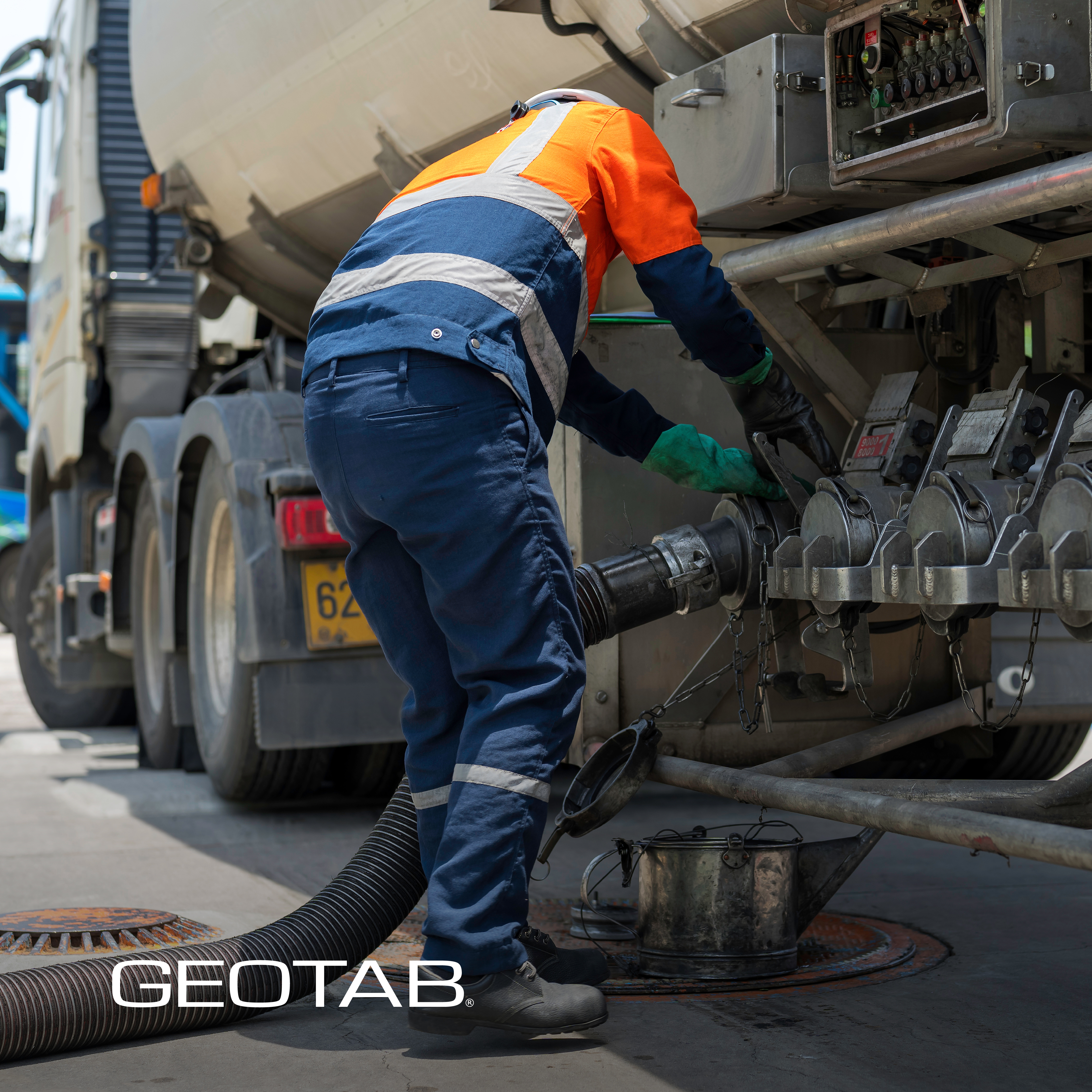9 strategies to increase fleet fuel efficiency and lower fuel costs
Increasing fuel efficiency means immediate cost savings and long-term operational benefits for Australian companies. Even a 10% improvement can save mid-sized fleets tens of thousands of dollars and reduce their carbon footprint.
By Geotab Team
Dec 2, 2025

Key Insights
- On average, fuel costs make up 60% of a total fleet budget, so investments in more fuel-efficient vehicles can save thousands of dollars every year.
- Fleet telematics systems provide real-time visibility into fuel consumption patterns and inform route optimisation that can cut unnecessary kilometres and reduce idle time, helping fleets save upward of $10,000 every year on fuel costs.
- Driver behaviours like speeding, idling and harsh braking can impact fuel consumption by up to 30%.
- Regular preventative vehicle maintenance, like proper tire inflation and engine health monitoring, can make a big difference in fuel efficiency, as even under-inflated tires can reduce fuel economy by up to 3%.
By some estimates, operating costs for Australian freight businesses have ballooned by 20% over the past six years, with both margins and profits squeezed by petrol prices, interest rates, labor, maintenance and tyres. Driver behaviour can impact fuel consumption by up to 30%, so there’s no question that improved fleet fuel consumption means significant cost savings. Even a 10% change could save a mid-sized fleet tens of thousands of dollars every year.
As petrol prices continue to rise and organisations face increasing environmental pressures, fleet managers often find themselves at the crossroads of profitability and sustainability. Every litre saved means cost relief. That’s why it’s so important to maximise your fleet’s fuel economy.
But reducing fleet fuel costs isn’t just about cutting back on spend — it’s future-proofing your operation. Strategies that reduce fuel consumption also lower your fleet’s carbon footprint, making efficiency tactics a win-win. Below, you can learn proven, practical strategies to reduce petrol costs, minimise tailpipe CO2 emissions and transform fuel efficiency:
1. Investigate fuel usage trends
Telematics solutions are the secret to managing fleet fuel costs and creating an environmentally friendly organisation.
Modern telematics systems provide heightened visibility into fuel consumption patterns by tracking aggressive driving, speeding, idling times and more. Fleet managers can use this data to identify driver patterns and coaching opportunities.
The most impactful fuel efficiency techniques managers can implement come from these four key driver behaviours:
- Speed management: Reducing speed can yield significant fuel savings. By driving at 90kmh instead of 100kmh, you can reduce fuel use by nearly 10%, and can diminish tyre wear, driver stress and crash risk.
- Acceleration patterns: Faster acceleration burns more fuel. The harder a driver pushes on the accelerator, the more RPMs the engine will turn, burning more fuel inefficiently.
- Momentum: Once up to speed, conserving momentum is critical to fuel efficiency. Drivers can do this by increasing following distance so they don’t have to brake suddenly, driving in a higher gear that uses fewer RPMs and reducing heavy acceleration on hills or in mountain terrain.
- Idle time: Leaving a truck running is a major waste of fuel. Using technology like an auxiliary power unit and turning off engines while parked can minimise idle time, conserve fuel and improve overall kilometers per litre.
2. Optimise your route
Another game-changer is using telematics for route optimisation. Telematics can track fuel usage, efficiency and time on the road, and fleet managers can ensure drivers are taking the most efficient route. When used to its fullest extent, this data can cut unnecessary kilometres (saving fuel) and optimise dispatch decisions.
3. Practice preventative maintenance
Fleet telematics and fuel efficiency systems are critical for preventative and predictive maintenance monitoring. Engine malfunctions, faulty oxygen sensors and improperly inflated tires can significantly reduce fuel economy. According to research, under-inflated tires alone can reduce fuel efficiency by up to 3% and decrease tire life by 10% for every 10% decrease in recommended pressure.
Advanced telematics platforms like Geotab provide real-time vehicle health monitoring, tracking everything from tire pressure alerts to maintenance needs, alerting managers of potential problems before a minor issue has time to become a costly repair.
4. Tailor vehicle selection to the workload
Choosing the right vehicle for the task makes a big difference in fuel management. A large truck carrying a small load for a short distance will only waste your fuel, so it’s important to always rightsize your vehicle.
5. Lighten the load
The lighter a vehicle’s load, the better the fuel efficiency. Translating US EPA statistics into local terms, an extra 100 kg adds roughly A$0.026 per litre to your fuel costs. The exact impact will vary depending on your vehicle’s efficiency and local petrol prices. Roof cargo is often the biggest culprit here, which is why drivers should only carry what they need.
6. Start investigating EVs
You might not be ready to switch your entire fleet to EV overnight, but now is a good time to start checking out electric alternatives to understand how they might fit into your fleet. In the right scenario, EVs can provide a much lower total cost of ownership and are, of course, much more environmentally friendly.
7. Train drivers on fuel-efficient driving habits
Sometimes the best way to improve fuel usage is by training drivers on simple but effective driving habits. These techniques can help optimise fuel usage, keep the driver safe and extend vehicle life:
- Minimising idling
- Avoiding aggressive acceleration
- Anticipating traffic flow
- Maintaining steady speeds
8. Leverage technology for fuel efficiency
When it comes to fleet management, you can’t manage what you’re not measuring, and without the right technology, you’re left in the dark. To improve your fleet’s fuel efficiency, you need the right tools.
You’ll want a telematics solution that can track:
- Fuel consumption
- Kilometres driven
- Fuel speed
- Idling time
- CO2 emissions
The more granular your data, the better-informed your decisions. Benchmark your fleet’s performance against previous duty cycles and compare against other industries to improve fuel usage.
Build fuel-efficient fleets with Geotab
Better fleet fuel efficiency requires more than just good intentions. You’ll need intelligent fleet management tools and complete visibility into your fleet’s performance.
Geotab’s integrated telematics platform turns fuel management from reactive choices to data-driven decisions by providing real-time insights into driver behaviour, route efficiency, vehicle health and fuel consumption patterns. It does this by consolidating vehicle data into a single, actionable and easy-to-use fleet fuel management dashboard. Fleet managers can quickly identify immediate cost-saving opportunities, coach drivers who need the extra help and make stronger fuel efficiency decisions — all while increasing overall fleet performance.
The road to sustainable fuel cost optimisation starts with understanding your fleet’s current status. Geotab’s approach to fleet fuel efficiency monitoring equips you with the tools you need to reduce operating costs and exceed sustainability goals.
Curious to see how much you can save? Check out Geotab’s fleet fuel management system so you can start lowering your costs and optimising fleet productivity.

The Geotab Team write about company news.
Table of contents
- 1. Investigate fuel usage trends
- 2. Optimise your route
- 3. Practice preventative maintenance
- 4. Tailor vehicle selection to the workload
- 5. Lighten the load
- 6. Start investigating EVs
- 7 . Train drivers on fuel-efficient driving habits
- 8. Leverage technology for fuel efficiency
- Build fuel-efficient fleets with Geotab
Related posts
.jpg)

Fuel efficiency techniques every transport operator should know
December 2, 2025
3 minute read
Dash cams vs. all-in-one video telematics: the difference and why choose an all-in-one solution
November 19, 2025
3 minute read


Powering what's next: Key takeaways from the Geotab ANZ Partner Summit 2025
October 6, 2025
3 minute read
